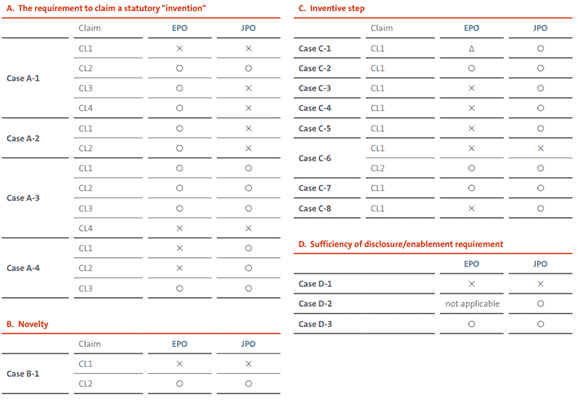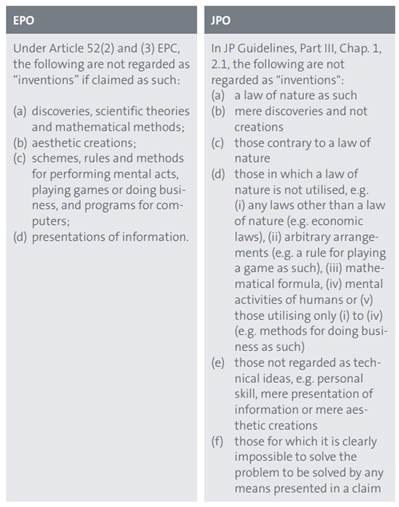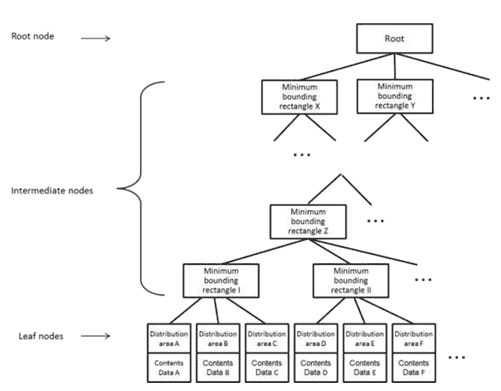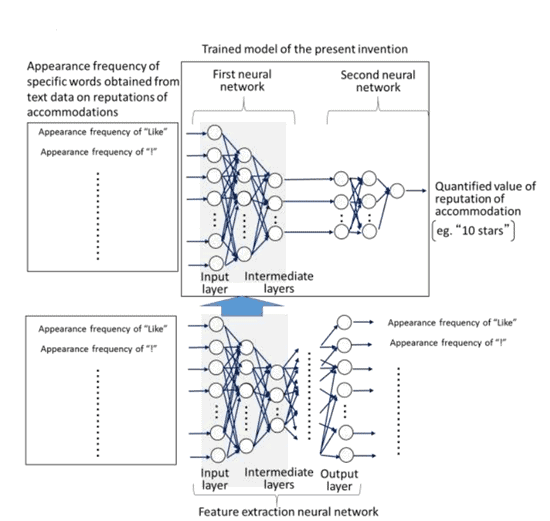
The European Patent Office (EPO) published a study that was jointly conducted with the Japan Patent Office (JPO) and aimed to provide patent applicants and practitioners with insights into how each office examines applications directed to computer-implemented/software related inventions. The study can be found here. Herein, references to “the study” refer to this document.
In this first article, we provide a summary results of the study in general, and concentrate on some examples of claims that were examined for whether their subject matter was excluded from patentability for not statutorily defining an invention.
The study, at a glance
16 cases were contrasted to examine whether the same claims would have different outcomes to their prosecution before the EPO and the JPO. 27 claims across these cases were examined and it was determined whether the offices refused or did not refuse these claims on the basis of failing, or fulfilling, one of four criteria: (i) being a statutory “invention,”; (ii) novelty, (iii) inventive step, (iv) sufficiency.
The below table (taken from page 18 of the study) summarises the results: (in the table O denotes that a claim was not refused, X denotes that the claim was refused, and ∆ denotes the claim whose outcome before the EPO was dependent on its formulation)
(in the table O denotes that a claim was not refused, X denotes that the claim was refused, and ∆ denotes the claim whose outcome before the EPO was dependent on its formulation)
(i) being an invention
4 cases totalling 13 claims were examined for the first criterion – whether the claims defined a statutory invention within the meaning of the European Patent Convention (EPC) and the Japanese Patent Act (JPA).
The EPO and JPO were in agreement on 7 claims – 5 of which each office agreed met the requirement on being an invention and 2 of which each office did not.
Of the remaining 6 claims, the EPO refused two for not being an invention where the JPO did not, and the JPO refused four claims where the EPO did not.
Some discrepancy is perhaps unsurprising given the different criteria applied by each office to assess whether a given subject matter is not regarded as an “invention”, despite the overlap between the exclusions set out in Article 52 of the European Patent Convention (“EPC”) and Part III, Chapter 1, 2.1, of the Examination Guidelines for Patent and Utility Models in Japan (the “JP Guidelines”), as shown in the table below (taken from page 6 of the study): We briefly remark that, before the EPO, a claim which has at least one feature that conveys “technical character” will not fall under the exclusions listed in Article 52 EPC and this is the same for claims to programs for computers as much as for claims to any other subject matter. Clearly, this assessment may yield a different result when contrasted to the JPO’s approach , wherein exclusion from patentability is assessed having regard to the claimed invention as a whole.
We briefly remark that, before the EPO, a claim which has at least one feature that conveys “technical character” will not fall under the exclusions listed in Article 52 EPC and this is the same for claims to programs for computers as much as for claims to any other subject matter. Clearly, this assessment may yield a different result when contrasted to the JPO’s approach , wherein exclusion from patentability is assessed having regard to the claimed invention as a whole.
These approaches will be contrasted when we discuss the specific cases examined by both offices for this criterion later in this article.
(ii) novelty
Only one case having two claims was examined for the second criterion – whether the claims were novel – and both offices agreed that the first of these was novel and that the second was not. This agreement is not surprising as the approach of both offices to novelty is considered to be similar.
(iii) Inventive Step
8 cases totalling 9 claims were examined for the third criterion – whether the claims possessed an inventive step. The EPO and JPO agreed on 4 claims – 3 of which each office agreed possessed an inventive step and 1 where each office did not. Interestingly, the JPO allowed all 5 of the remaining claims whereas the EPO refused them (although for one claim it was commented briefly that a different formulation of the claim could yield a different outcome).
Some discrepancy here was also expected given the different approaches of each office to inventive step, in particular the lack of a distinction being made by the JPO between features that confer a technical effect and those that do not.
(iv) Sufficiency
Finally, 3 claims across 3 cases were examined for the fourth criterion – sufficiency. The two offices were in agreement on two claims, refusing one claim and not refusing the other. The remaining claim was deemed sufficient by the JPO but was refused by the EPO for lacking an inventive step (the claim in this case was considered a mere automation of something non-technical which would be refused for a lack of inventive step without an assessment for sufficiency being performed).
Agreement here was also expected since we consider the stipulation of Article 83 EPC to be similar to Article 36(4) JPA.
In this article, we now turn to the cases where the first requirement was assessed. These cases were all taken from Annex A (Case I) or Annex B (Cases II-IV) of the JP Guidelines.
Assessing whether a claim recites an “invention”
Case I
The first of the four cases concerns data for 3D printing dolls and a method of 3D printing dolls.
Claim 1 is directed to the 3D printing of data relating to dolls which is read and modelled by a 3D printer. The data includes three-dimensional shapes and colour tones of the dolls to be modelled.
The EPO refused this claim, saying that it amounted to no more than a mere presentation of information, and that the informational content or “meaning” of the data, i.e. the shapes and colour tones, was irrelevant and did not provide a technical effect. The JPO came to the same conclusion regarding claim 1.
Claim 2 is an independent claim relating to the 3D printing of the dolls themselves. The claimed method comprises steps of reading 3D printing data, and controlling a modelling unit to dispense modelling resin and colourants based on the shapes and colour tones defined by the data. Unsurprisingly, both offices agreed that this claim constituted an invention. Even though the shapes and tones described by the data are still considered to be non-technical, unlike in claim 1, the data in claim 2 is used as part of a 3D printing process (which is clearly a technical process).
Claims 3 and 4 respectively recite the 3D printing data of claim 1 stored in a computer-readable storage medium and a computer-readable storage medium storing the data of claim 1. Such claims are not excluded from patentability before the EPO since they define data, stored or embodied, on a physical medium which necessarily involves technical means. In contrast, the JPO refused these claims for the same reasons as for claim 1.
The different outcomes of claims 3 and 4 before the two offices illustrate the office’s different attitudes to storage mediums. In particular, reciting a storage medium (e.g. a physical entity) storing data is enough to avoid an exclusion under Article 52 EPC before the EPO, but may not be sufficient in order to avoid an exclusion before the JPO.
Case II
The second case is directed to allocating unmanned autonomous vehicles.
Claim 1 is directed to a system comprising a vehicle allocation server, a portable terminal, and unmanned autonomous vehicles. Claim 2 is directed to a method implemented in a system comprising the server, terminal, and autonomous vehicles. According to both independent claims 1 and 2, when the server receives a vehicle allocation request from a user, it allocates an unmanned autonomous vehicle to that user.
Before the EPO, claim 1, being directed to a system having physical entities, trivially avoids the exclusions of Article 52 EPC. Similarly, method claim 2 recites the interaction of features that are technical (the server, terminal, and vehicles) and therefore the method claim is also considered to involve technical means according to EPO practice.
The JPO took the opposite view, and neither claim was considered to define an invention for the following reasons: Considering the subject matter of the claims as a whole, neither claim recited the actual control of a vehicle nor any actual information processing performed by a vehicle. The claims therefore were considered not to fall under the term “invention”, since they do not provide a specific implementation of the software processing by using hardware resources.
At the EPO, a similar assessment would take place, however, this would be performed as part of the subsequent inventive step analysis rather than as part of the assessment whether the claims constitute a (technical) “invention” or not. For these claims, the presence or absence of an inventive step would appear to boil down to the feature of allocating an autonomous vehicle (perhaps in combination with the other features), and merely “allocating” a vehicle to a requester does not confer a technical effect. However, the study noted that if this feature were to be amended to recite that the vehicle was adapted to drive autonomously to the requested position, then this would confer the technical effect of provide a vehicle to a requester at a specified location. We assume that such an amendment would then also render the amended claim to fall under the term “invention” as defined by Part III, Chap. 1, 2.1 of the JP Guidelines.
Case III
The third case relates to a data structure for distributing content to users who own gaming machines. A contents distribution server identifies gaming contents data to send over a network to specific gaming machines corresponding to the current locations of the machines. In this way, each machine receives tailored content depending on their location.
The “tree-structured” data structure comprises an uppermost root node, having intermediate nodes thereunder, and lowermost leaf nodes having location information and contents data. This is best seen from the below Figure (from the JP Guidelines, Annex B, Section 3.2, Case 2-11, also found on page 24 of the study): Claim 1 recites the data structured as above “wherein the data is stored in a content distribution server and is used by the server to perform processing to identify leaf nodes corresponding to distribution areas that geographically bound current location information input as a search key in accordance with… the root node or intermediate nodes.”
Claim 1 recites the data structured as above “wherein the data is stored in a content distribution server and is used by the server to perform processing to identify leaf nodes corresponding to distribution areas that geographically bound current location information input as a search key in accordance with… the root node or intermediate nodes.”
This allows the server to identify areas that geographically contain the current location (based on data from the gaming machines themselves, as a search key) and then distribute content data to users corresponding to the identified area. In short, the data structure allows an area in the data structure having location-specific content to be found based on the actual location of a device so that the appropriate content can be distributed to the device.
Claim 2 is a dependent claim which recites a content data distribution method performed by a server storing the data of claim 1 and according to which leaf nodes corresponding to the distribution areas that geographically contain the current location (acquired from the gamine machine as a search key) are identified via the data structure.
Claim 3 limits the claim 2 method by specifying that the content data is data on items or characters used on gaming applications that run on gamine machines.
Claim 4 recites “the contents data distributed to users by means of the method described in claim 3.”
The EPO and JPO were in agreement on all claims, with claims 1-3 being considered to define an invention and claim 4 considered to be excluded.
Both offices agreed that claim 1 defines an invention since it defines physically embodied data including a data structure. According to the Guidelines for Examination of the EPO, G-II, 3.6.3, a computer-implemented data structure embodied on a medium has technical character, and claim 1 defines such a data structure stored in a contents distribution server. That such structure is stored in such a server also meant that it was considered to be information processing realised by hardware resources, thus being the creation of a technical idea utilising a law of nature and hence and invention before the JPO.
Claims 2 and 3 are also not excluded by the EPO as they define a computer-implemented method (of data storage and retrieval). The JPO also accepted that they define inventions for the same reasons as for claim 1, the method being a cooperation between software and hardware resources.
Claim 4 however is a claim to data “as such” (in fact, it can also be argued that this claim constitutes the presentation of information as such) and is thus excluded under Article 52 EPC. The JPO also considered the claim to be excluded for being the mere presentation of information.
Case IV
The fourth and final application relates to a trained model for analysing the reputation of an accommodation. It utilizes two neural networks to analyze text data of reputations of accommodations to quantify a value of the reputation based on the frequency of specific words present in the text data, as shown in the explanatory drawing below (from the JP Guidelines, Annex B, Section 3.2, Case 2-11, also found on page 29 of the study): Claims 1 and 2 are independent claims respectively directed to a trained model and computer program for causing a computer to output a quantified value of an accommodation. Both claims were excluded by the EPO for relating to no more than abstract method that could be used by a computer, with claim 2 (to the computer program) not being deemed to produce any “further” technical effect (e.g. by solving a technical problem) that goes beyond the “normal” physical interactions between software and hardware.
Claims 1 and 2 are independent claims respectively directed to a trained model and computer program for causing a computer to output a quantified value of an accommodation. Both claims were excluded by the EPO for relating to no more than abstract method that could be used by a computer, with claim 2 (to the computer program) not being deemed to produce any “further” technical effect (e.g. by solving a technical problem) that goes beyond the “normal” physical interactions between software and hardware.
The JPO considered the model of claim 1 to be a “program” since it is the model itself which causes a computer to output the quantified values, by calculating based on trained weights in the first and second neural networks in response to the frequency of specific words in the accommodations. In contrast to the EPO, the JPO considered both claims to fall under the term “invention”, i.e. to not be excluded from patentability.
This case is an interesting illustration of the different offices’ approaches to artificial intelligence and machine learning. In particular, the EPO tends to view this subject matter as no more than a mathematical method “as such” (of course, this will depend on the exact claim) whereas we consider the approach of the JPO to be more favourable to applicants in this area.
Claim 3 recites a computer-readable storage medium storing the computer program of claim 2.
On claim 3 both offices were in agreement that the subject matter was not excluded, with the JPO providing similar reasons as for claim 2. What claim 3 recites beyond claim 2 is a physical entity (e.g. a device) storing the instructions, which is enough to avoid the exclusion of Article 52 EPC, as discussed above for claim 4 of Case I.
Summary and Conclusion
As can be seen from the various cases above, the JPO and the EPO somewhat differ in their approach to assessing exclusion from patentability resulting in similar outcomes for some cases but different outcomes for others. Nevertheless, the same eventual outcomes could be reached by both offices on different grounds (such as inventive step), although of course this will depend on the claims.
For applicants who wish to apply for patent protection both in Japan and in Europe, this may mean carefully drafting the independent claims of an application directed at a computer-implemented invention such that they fulfil the criteria of both Art. 52 EPC and Part III, Chapter 1, 2.1 of the JP Guidelines. For instance, to meet both criteria we would recommend drafting independent claims that include (at least) one feature which clearly conveys technical character according to EPO practice, as well as ensuring that the claim as a whole meets the definition of “invention” as set out by the JPA.
This is for general information only and does not constitute legal advice. Should you require advice on this or any other topic then please contact hlk@hlk-ip.com or your usual Haseltine Lake Kempner advisor.
